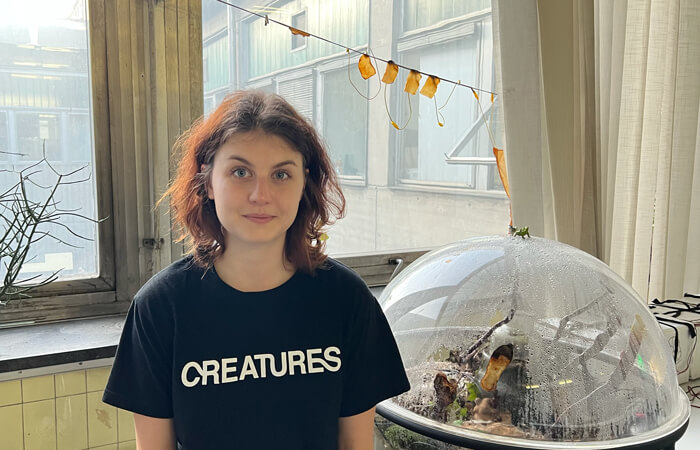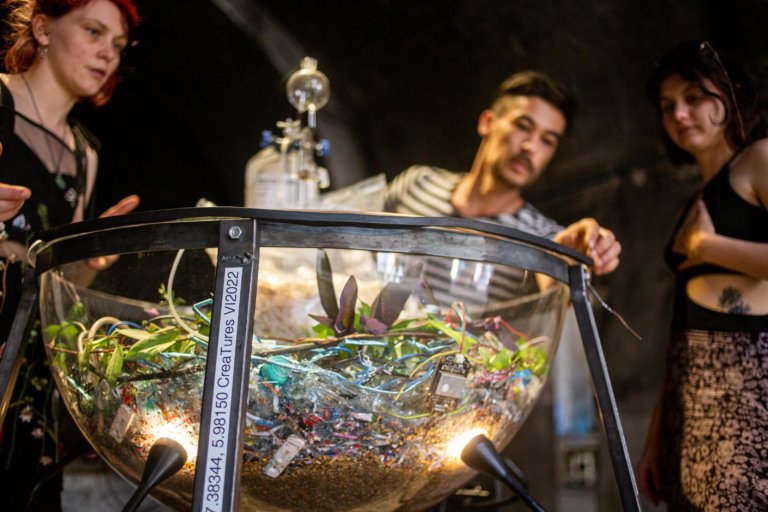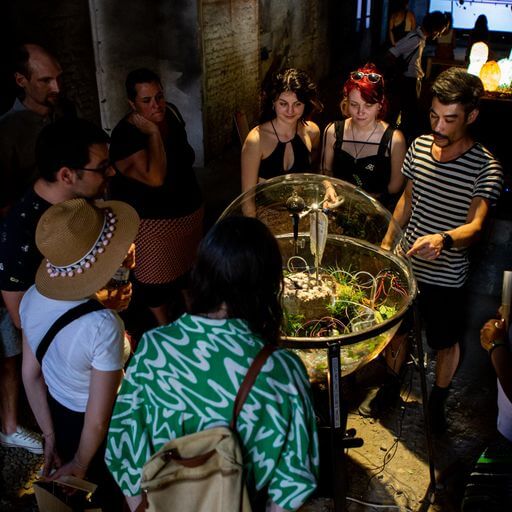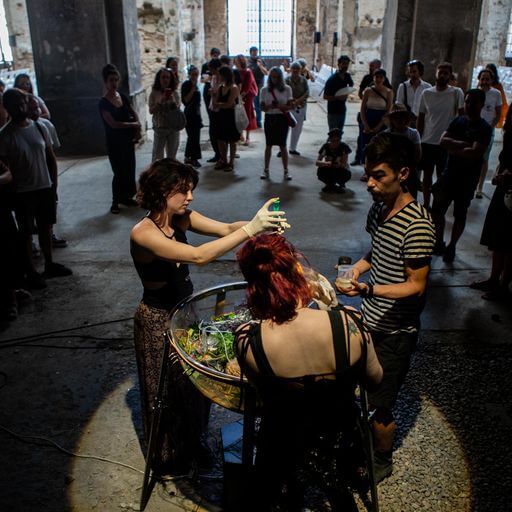Eva Debevc
How to look at the code of the system to understand its absurdity
In the dark times before the big collapse, there was a gloomy, monstrous presence hovering in the world. It was all this time or maybe it came into existence just a moment before its vastness engulfed all of the silly creatures’ minds so no one could recognize the thing or describe its shape and ways; but everyone could feel it. They call this phenomenon ‘white blindness.’ There were speculations of its birth from the endless fields of data. Some silly creatures received the calling of the woods, so they roamed curiously into the forest lands that were threatened by the presence. They fell into the wise branches of the rooted creatures who taught them ways of slowness, stealth and meditative patience. From their feet, silly creatures were pulled underground by the unknowing strings of creatures of the webs who mastered information transmission and movement of particles. They had the immense strand to support other life forms, and were the old mother of all. Silly creatures soaked up and glowing with sight, climbed from the earth into the air, where spirit slid through their nostrils into their minds. Through the language of giggles, they revealed to them secrets of play, carelessness, destabilization and chaos. Silly creatures saw the presence for the first time, they learned how to look at the code of the system to understand its absurdity and how to see past that code into the primeval phase of things. This attracted other silly creatures and they performed rituals of magic together to strengthen awareness, care and compassion, which were the tools used to put the presence into latent sleep, and added a place where beginning and end meet. This is why we still have forests today and can send messages or store meaningful data through Wood Wide Web. You can find molecular version of this message at this account.
I packed my experience of a part of my Creature’s journey into a form of a mythical story about the different creatures we encountered on this journey. I use the metaphor of silly creatures for human beings, because a lot of our behavior towards others and the ecosystem is silly. And I saw this festival in Seville like a gathering of silly creatures who tried to create something with care. And that’s the magic rituals in the messages and the forest beings are plants and mushrooms and other forces of nature that are driving us through our creative practice and the project with Taro is presented as some creatures of the woods in this story because I am really interested in how to bring myth back to the place of communicating knowledge. Because I’m from science and there’s just a lot of raw data that’s contextualized in a really boring way. There’s nothing imaginative that would show you some archetypal meaning of all of this data, if that makes sense.
Trust yourself
An advice for younger me, it would be just do what you have to do. Everything’s going to work out. Trust yourself.
In this data obsessed century, people have to wear these electronic devices to see how they feel
I find it really funny that in this data obsessed century, people have to wear these electronic devices to see how they feel. Like, you wake up in the morning wondering, can you look at how I am feeling? And then you look at your watch and, “I’m feeling great today.” And the heartbeat, my heart beats perfectly.
Mushrooms show us to change how we work as a society… I had this dream of living inside a mushroom
There is a term plant blindness that’s used for plant blindness. It’s what most people have. So when you go outside, you just see, you know, a person, a red car, and then just a bunch of trees, like green trees or green grass. It’s just like the scenery to people usually. But I think this practice we have is like exposing all these beings as complex, singular beings with their own life and immense potential showing their importance in the ecosystem, because they’ve been here long before us and they will probably stay here long after us. They show us to change how we work as a society, I hope, in the way we build our urban environment but in a real way where we create infrastructure with living organisms. I had this dream of living in a mushroom, just living inside a living mushroom.

About Eva Debevc
Born April 23 rd 1998 in Ljubljana, I grew up in Solkan, where I finished elementary school and continued my education in Gimnazija (grammar school) Nova Gorica. I passed an exam of talent in visual arts. I participated in youth theater group AMO for one season, as co-author and actor. I got a
Bachelor’s degree in Biology and I’m currently enrolled in a Master’s degree program specializing in Molecular and Functional Biology. In my work as a researcher I focus on biomaterials. In 2021 I took part in training for mentors at Kersnikova Institute for investigative art, where I am currently working at Rampa Lab as a mentor and at Vivarium laboratory as a researcher. Working as a mentor, I organize, plan and teach workshops, combining investigative art and science at Kersnikova, using DIY techniques, bio-hacking and electronics. In my work as a researcher I focus on biological materials, mostly mycelium and its interactions with other organisms, technology and sound. I help visiting artists prepare workshops in which I also participate (MyCoBiont – Gobnjak: Growing mycelial leather, Mary Maggic: Becoming with fungi, Martin Howse: Radio Mycelium, Maja Smrekar and Gjino Šutić: Fertilize me, Adam Zaretsky: Field Notes from a Transgenic Animal Facility & Making Others With Others…). I co-created two art installations as a part of the project Taro Knopp: ml-iso|la|ti|o|nis|mus, which were exhibited in module of Kapelica Gallery and at CreaTures festival at Real Fabrica de Artilleria in Seville (2022).
CreaTures resources
Knopp, T., Debevec, E. & Ambrožič, N. (2022) MyCoBiont [Festival Pechakucha presentation]. CreaTures Festival, Sevilla, Spain.
Kersnikova Institute (2022) MyCoBiont . Ljubljana, Slovenia.
Botero, A., Dolejšová, M., Choi, J. H-j. and Ampatzidou, C. (2022). Open Forest: Walking with Forests, Stories, Data, and Other Creatures.interactions 29 (1) 48–53. https://doi.org/10.1145/3501766



